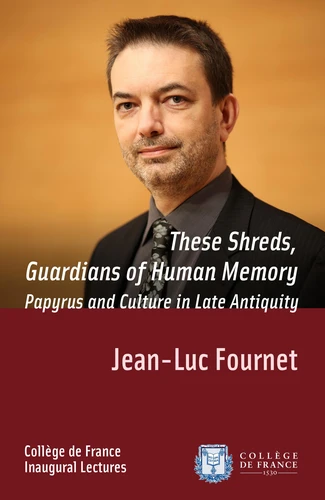These Shreds, Guardians of Human Memory: Papyrus and Culture in Late Antiquity. Inaugural Lecture delivered on Thursday 7 January 2016
Par :Formats :
Disponible dans votre compte client Decitre ou Furet du Nord dès validation de votre commande. Le format Multi-format est :
- Pour les liseuses autres que Vivlio, vous devez utiliser le logiciel Adobe Digital Edition. Non compatible avec la lecture sur les liseuses Kindle, Remarkable et Sony
 , qui est-ce ?
, qui est-ce ?Notre partenaire de plateforme de lecture numérique où vous retrouverez l'ensemble de vos ebooks gratuitement
Pour en savoir plus sur nos ebooks, consultez notre aide en ligne ici
- FormatMulti-format
- ISBN978-2-7226-0500-8
- EAN9782722605008
- Date de parution19/11/2018
- Protection num.NC
- Infos supplémentairesMulti-format incluant PDF avec W...
- ÉditeurCollège de France
Résumé
Papyrology, which burgeoned in the nineteenth century after the discovery of thousands of papyri in Egypt, consists in the study of Greek and Latin texts written on a transportable medium (papyrus, clay potsherds, wooden tablets or parchment). While inscriptions and literary sources can render a normative, idealized and sometimes deformed image of individuals, papyri - no matter how fragmented they may be - take us into their daily lives, thus making possible the archaeology of cultural practices.
Attempting to decipher "these shreds, guardians of the human memory" - to paraphrase Leonardo de Vinci - is the challenge of the papyrologist, who ceaselessly renews our knowledge of the past.
Attempting to decipher "these shreds, guardians of the human memory" - to paraphrase Leonardo de Vinci - is the challenge of the papyrologist, who ceaselessly renews our knowledge of the past.
Papyrology, which burgeoned in the nineteenth century after the discovery of thousands of papyri in Egypt, consists in the study of Greek and Latin texts written on a transportable medium (papyrus, clay potsherds, wooden tablets or parchment). While inscriptions and literary sources can render a normative, idealized and sometimes deformed image of individuals, papyri - no matter how fragmented they may be - take us into their daily lives, thus making possible the archaeology of cultural practices.
Attempting to decipher "these shreds, guardians of the human memory" - to paraphrase Leonardo de Vinci - is the challenge of the papyrologist, who ceaselessly renews our knowledge of the past.
Attempting to decipher "these shreds, guardians of the human memory" - to paraphrase Leonardo de Vinci - is the challenge of the papyrologist, who ceaselessly renews our knowledge of the past.












